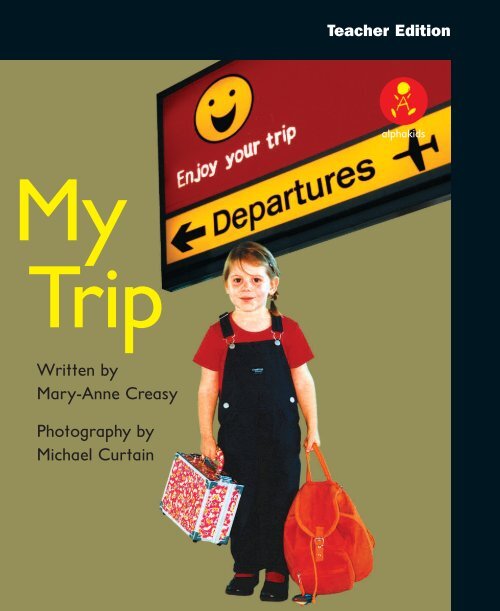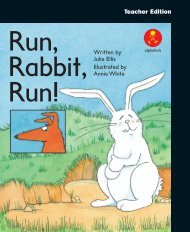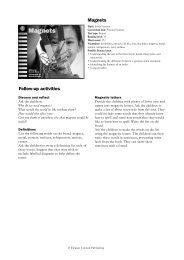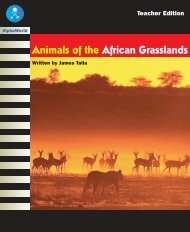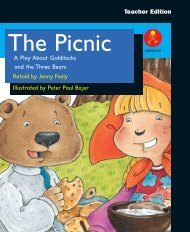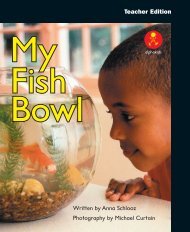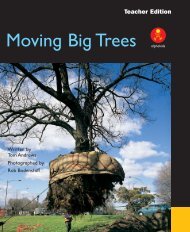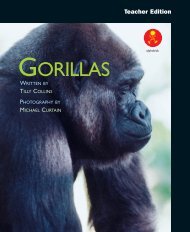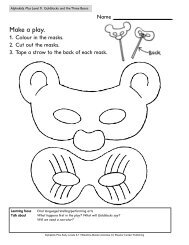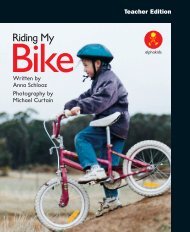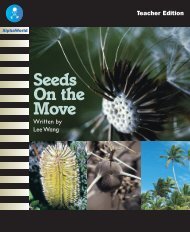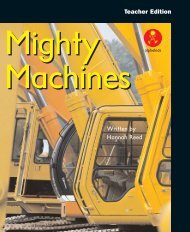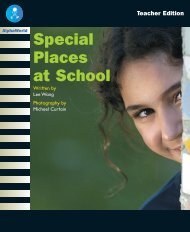Written by Mary-Anne Creasy Photography by Michael Curtain
Written by Mary-Anne Creasy Photography by Michael Curtain
Written by Mary-Anne Creasy Photography by Michael Curtain
- No tags were found...
Create successful ePaper yourself
Turn your PDF publications into a flip-book with our unique Google optimized e-Paper software.
Teacher EditionalphakidsMyTrip<strong>Written</strong> <strong>by</strong><strong>Mary</strong>-<strong>Anne</strong> <strong>Creasy</strong><strong>Photography</strong> <strong>by</strong><strong>Michael</strong> <strong>Curtain</strong>
Published edition© Eleanor <strong>Curtain</strong>Publishing 2004First published 2004Apart from any fair dealing forthe purposes of study, research,criticism or review, aspermitted under the CopyrightAct of Australia, no part of thisbook may be reproduced <strong>by</strong>any process, or transmitted inany form, without permissionof the copyright owner. Wherecopies of part or the whole ofthis book are made under PartVB of the Copyright Act, thelaw requires that records ofsuch copying be kept and thecopyright owner is entitled toclaim payment.Developed <strong>by</strong>Eleanor <strong>Curtain</strong> PublishingText: Nicole Di MarcoConsultant: Susan HillDesigned <strong>by</strong>Alexander StittProduction <strong>by</strong>Publishing SolutionsPrinted in ChinaISBN 0 7253 3406 11 2 3 4 5 6 7 8 904 05 06?How to use this bookBefore reading: TalkthroughTalk through the book with the children. Encouragethem to predict the text from the cover and thepictures, and to think about the information theyprovide. Direct the children’s attention to aspects ofthe text that may challenge them. Support the childrento deal with these challenges <strong>by</strong> asking theTalkthrough questions on each page.During reading: Observe and supportObserve the children as they read. Encourage them tomonitor their own reading as they comprehend thetext. As needed, support the children <strong>by</strong> helping themto discover and use reading strategies and cues to solveproblems and respond to reading challenges that arisein the text. Interruptions to the children’s readingshould be minimal and focused on specified learningneeds.After reading: Comprehension, returning tothe text, responding and writing linksTo further develop children’s understanding of thetext, select from activities found on page 16 and theinside back cover. These whole text, sentence and wordlevel activities reinforce the teaching focus of thisbook. Assessment ideas are provided to assist withplanning for further teaching.Text highlights• This book is a first-person recount of agirl’s unaccompanied plane trip.• Airport and travel vocabulary is used; forexample, check-in counter, flight deck,X-ray machine.• Colour photographs support and extendthe text.Vocabularyairport, checked, counter, flight deck, pilots,special, X-ray machine
Setting the contextHave you ever been on a plane? What was itlike? What did you do? Where did you go?Talk with the children about the steps yougo through before getting on a plane.What do you need to do before you get onthe plane? Where do you take your bags?What else happens?Introducing the bookThis is a book about a plane trip a girl madeto see her grandmother. It starts when hermother takes her to the airport and endswhen her grandmother meets her at theother end.Front coverWhat do you notice about the girl on thefront cover? Have you ever travelledanywhere <strong>by</strong> yourself?Title pageWhat is the girl carrying?Point out the names of the author andphotographer. Discuss their roles in makinga book.
My Trip Pages 2–3?TalkthroughWho is telling this story? How do you know?Who is the girl going to visit?Who takes her to the airport?Observe and supportCan the children interpret the inferences in the text?Does the girl’s grandmother live close <strong>by</strong> or far away? How doyou know?2
My Trip Pages 4–5?TalkthroughWho meets the girl at the counter? Kate is going to look afterthe girl on her trip.How might the girl be feeling when she says good<strong>by</strong>e to hermother?Observe and supportDo the children read the text with expression?Can you read the story as if you were the girl in the book? Howwould she say, ‘Bye Mum!’?4
My Trip Pages 6–7?TalkthroughWhat is happening here? Why is the girl giving the man herbag? Why is she walking through the X-ray machine?Observe and supportDo the children understand the purpose of thephotographs?How do the photographs help us to understand the story better?6
My Trip Pages 8–9?TalkthroughWhat is Kate giving the girl? Why? Where was the girl’s seatlocated?Observe and supportDo the children use a range of strategies to work outnew vocabulary?How did you work out the word ‘colouring’? Can you see a wordyou already know in colouring?8
My Trip Pages 10–11?TalkthroughThe pilots fly the plane. Where do the pilots sit? The book saysthat the pilots sit in the flight deck. What is a flight deck? Howdo you know?Observe and supportDo the children check what they read with the phonicinformation on the page?Point out a word, for example, ‘flight’.How did you know what that word was? What did you check atthe start of the word? What did you look for at the end of theword? What else did you check?10
My Trip Pages 12–13?TalkthroughWhat does Kate bring the girl? Did the girl enjoy her snack?Does she like to fly <strong>by</strong> herself?Observe and supportCan the children identify an exclamation mark andexplain what it is used for?Can you show me an exclamation mark? What does anexclamation mark tell you about how to read the text?12
My Trip Pages 14–15?TalkthroughWhat did the girl do when the plane landed? Is the girl stilltelling the story? How do you know?Observe and supportCan the children identify a question mark and explainwhat it is used for?Can you show me a question mark? What does a question marktell you about how to read the text?14
My Trip Page 16? TalkthroughWho is at the airport to meet the girl? What do the girl and hergrandmother do when they meet each other? Where will they gonow?16After readingBeing a meaning makerEncourage the children to support their responseswith evidence from the book as they discuss thesecomprehension questions.Where did the girl go on the plane?Why did she need to go through the X-ray machine?Who looked after her on the plane?How might she have felt before she went on the plane?How did she feel after her plane trip?
Being a code breakerExplore the following language features:• Hearing words: the children could beasked to listen for words that containother words; for example, myself,airport, grandma, check-in.• Punctuation: explore the use ofexclamation marks and questionsmarks.Being a text userRefer to the text when discussing thesequestions:Is this book fiction or non-fiction?Why do some of the photographs have whiteborders around them?What does this make them look like?Being a text criticHave you ever been on a plane?Do all children get to go on planes?Do all children get to fly <strong>by</strong> themselves?Responding to textThe children could work incooperative groups to take on therole of one of the people featured in thebook. Each character could retell thestory from her or his point of view.The children could be asked towrite about a time they flew on aplane or about what it might be like to flyon a plane.The children could explore thesound /pl/, as in ‘plane’. Theycould look for words that start with thissound in familiar texts and create anillustrated list.WritingDiscuss how we identify that the story istold in the first person. Then explain whatthe third person is and model retelling apage of the story in the third person.Ask the children to work in pairs torewrite a page of the book in the thirdperson. If each pair does a different page,the children’s work could be collated tomake a group book.AssessmentCan the children:• identify the words that tell the reader that the girl is telling the story?• use contextual information to explain the meaning of vocabulary, such as checkincounter, X-ray machine and flight deck?whole text activity sentence activity word activity
alphakidsMyTrip<strong>Written</strong> <strong>by</strong><strong>Mary</strong>-<strong>Anne</strong> <strong>Creasy</strong>TeacherEditionOtherbooksat thislevelBa<strong>by</strong> BearGoes Goes Visiting for a WalkRetold <strong>by</strong> Jenny FeelyIllustrated <strong>by</strong> Peter Paul Bajeralphakids<strong>Photography</strong> <strong>by</strong><strong>Michael</strong> <strong>Curtain</strong>Topic: TravelCurriculum link: SOSEText type: RecountLevel: 10Word count: 136High-frequency words: a, an, and, at, <strong>by</strong>, could,get, had, he, I, is, me, my, on, put, said, saw, she,some, there, to, was, went, what, when, where’sVocabulary: airport, checked, counter, flight deck,pilots, special, X-ray machinePossible literacy focusUsing a range of information on the page tounderstand airport and travel vocabulary.Who’s ThatKnockingAt My Door?Retold <strong>by</strong> Marilyn WoolleyIllustrated <strong>by</strong> Steve AxelsenalphakidsReptilesalphakidsSebastian’sNew Sister<strong>Written</strong> <strong>by</strong><strong>Mary</strong>-<strong>Anne</strong> <strong>Creasy</strong>Illustrated <strong>by</strong>Alex StittSpidersalphakidsalphakidsSummaryThis book is a simple recount about a girl’sunaccompanied plane trip.<strong>Written</strong> <strong>by</strong> Sarah O’Neil<strong>Written</strong> <strong>by</strong> Hannah Reed<strong>Photography</strong> <strong>by</strong> Patrick HonanISBN 0- 7253- 3406- 19 780725 334062alphakids


